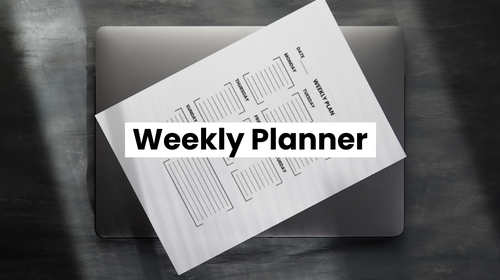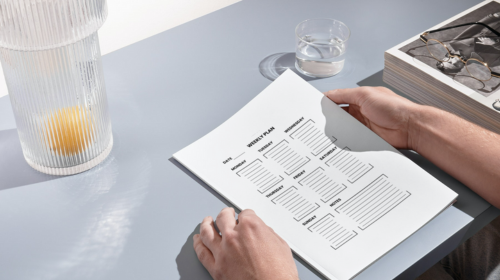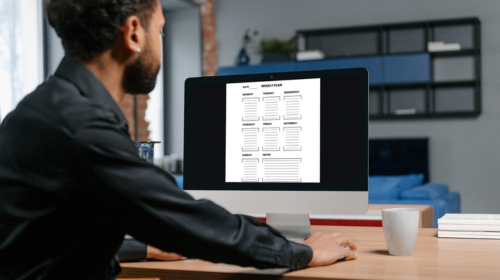Weekly Planner: Your Perfect Companion for an Organized Week
Benefits of Using a Weekly Planner
A weekly planner is a powerful tool for organizing your life and boosting productivity. Here are some of the key benefits:
Improved Time Management
- Prioritization: Helps you focus on important tasks and deadlines.
- Time Allocation: Efficiently distributes time among different activities.
- Task Breakdown: Breaks down large tasks into smaller, manageable steps.
- Reduced Procrastination: Encourages timely completion of tasks.
Increased Productivity
- Goal Setting: Aligns tasks with overall objectives.
- Focus: Minimizes distractions and maximizes output.
- Progress Tracking: Monitors achievements and identifies areas for improvement.
- Efficiency: Optimizes workload and time utilization.
Reduced Stress
- Organization: Creates a sense of control and order.
- Balance: Promotes work-life balance and prevents burnout.
- Clarity: Reduces anxiety by providing a clear overview of commitments.
- Mindfulness: Encourages focus on the present moment.
Other Benefits
- Enhanced Memory: Acts as a reliable external memory for appointments and tasks.
- Improved Decision Making: Provides a clear picture of available time and resources.
- Increased Accountability: Helps you stay committed to goals and deadlines.
- Personal Growth: Facilitates habit formation and goal achievement.
How Can a Weekly Planner Help Improve Time Management Skills?
A weekly planner is a powerful tool for enhancing time management skills. Here’s how:
- Visual Overview: It provides a clear picture of your entire week, allowing you to see potential conflicts or overlaps in your schedule.
- Prioritization: Helps you identify important tasks and allocate time accordingly, ensuring that high-priority items receive the attention they deserve.
- Time Allocation: By breaking down larger tasks into smaller, manageable steps and assigning specific time blocks, you can effectively utilize your time.
- Goal Setting: You can set weekly goals and track progress, staying focused on what matters most.
- Flexibility: Unexpected events can disrupt your schedule. A planner allows you to adjust your plans accordingly, minimizing stress and maximizing productivity.
- Habit Formation: Consistent use of a planner helps you develop good time management habits that can be applied to other areas of your life.
By effectively using a weekly planner, you can gain better control over your time, reduce stress, and increase overall productivity.
For products in the Productivity category click here
What Are Some Ways a Weekly Planner Can Help Reduce Stress?
A weekly planner can be a powerful tool for stress reduction. Here’s how:
- Organization and Clarity: Seeing your commitments laid out visually can provide a sense of control and clarity, reducing feelings of overwhelm.
- Prioritization: Identifying important tasks and scheduling them first can help you focus on what matters most, reducing anxiety about unfinished business.
- Time Management: Effective time allocation prevents rushing and last-minute stress.
- Balance: Scheduling time for relaxation and self-care activities promotes work-life balance, which is essential for stress management.
- Mindfulness: Focusing on the present moment and your schedule can help reduce anxiety about the future.
- Reduced Overwhelm: Breaking down large tasks into smaller, manageable steps makes them less daunting.
By using a planner effectively, you can create a sense of calm and order in your life, leading to reduced stress levels.
How Does Using a Planner Lead to Increased Productivity?
A weekly planner can be a game-changer when it comes to increasing productivity. Here’s how:
- Clear Focus: By outlining tasks and deadlines, you can concentrate on what truly matters, avoiding distractions and time-wasting activities.
- Time Management: Effective time allocation ensures that tasks are completed efficiently, maximizing output.
- Goal Setting and Tracking: Setting weekly goals and monitoring progress helps you stay motivated and accountable.
- Prioritization: Identifying important tasks and scheduling them first ensures that critical activities receive the necessary attention.
- Reduced Procrastination: Having a clear plan and schedule can help overcome procrastination and maintain momentum.
- Improved Decision-Making: A clear overview of your commitments allows for better decision-making regarding time allocation and resource management.
- Increased Efficiency: By minimizing wasted time and effort, you can accomplish more in less time.
By consistently using a planner, you’ll develop better time management habits, reduce stress, and ultimately increase your productivity.
Features of a Customizable Weekly Planner
A customizable weekly planner offers unparalleled flexibility to tailor your planning experience to your specific needs and preferences. Here are some key features to look for:
Layout Customization
- Grid or lined pages: Choose between grids for visual planning or lines for note-taking.
- Day-per-page or two-page spread: Opt for a single-page view for detailed planning or a two-page spread for a broader overview.
- Time blocking or open format: Decide whether to structure your day with time blocks or prefer a free-form approach.
Content Customization
- Habit trackers: Monitor and build positive habits.
- Goal setting sections: Define and track your objectives.
- Mood trackers: Monitor emotional well-being.
- Meal planning spaces: Organize your weekly meals.
- Financial trackers: Manage your budget and expenses.
- Note-taking areas: Jot down ideas, reflections, or reminders.
- Customizable sections: Add your own sections for specific needs.
Design Customization
- Cover options: Choose from various designs, colors, or even personalize your photo.
- Page dividers: Add visual separation between sections.
- Stickers or washi tape: Decorate your planner to match your style.
- Customizable fonts and colors: Personalize the planner’s appearance.
Additional Features
- Digital or physical format: Choose based on your preference.
- Sync with other devices: For easy access and updates.
- Expandable sections: Add more pages as needed.
- Durable materials: Ensure longevity and withstand daily use.
By selecting a planner with these customization options, you can create a personalized system that effectively supports your goals and lifestyle.
What Are Some Common Features Found in Customizable Planners?
Customizable planners offer a wide range of features to cater to individual preferences and needs. Here are some common elements you’ll find:
Layout and Format
- Daily, weekly, or monthly spreads: Choose the time frame that works best for you.
- Grid, lined, or blank pages: Opt for the style that suits your note-taking or planning approach.
- Horizontal or vertical layout: Determine the orientation that best fits your visual preference.
Content Customization
- Habit trackers: Monitor and build new habits.
- Goal setting sections: Define and track your objectives.
- Mood trackers: Monitor emotional well-being.
- Financial trackers: Manage budgets and expenses.
- Meal planning spaces: Organize weekly meals.
- Note-taking areas: Jot down ideas, reflections, or reminders.
- Customizable sections: Add pages for specific needs (e.g., fitness, travel, projects).
Design Elements
- Cover options: Choose from various designs, colors, or personalize with photos.
- Page dividers: Separate sections visually.
- Stickers or washi tape: Decorate and personalize your planner.
- Customizable fonts and colors: Create a unique look.
Additional Features
- Digital or physical format: Choose based on your preference.
- Sync with other devices: For easy access and updates.
- Expandable sections: Add more pages as needed.
- Durable materials: Ensure longevity and withstand daily use.
By combining these features, you can create a planner that perfectly aligns with your lifestyle and goals.
How Can Users Personalize Their Planner to Suit Their Needs?
Personalizing your planner is essential to make it a truly effective tool. Here are some ways to customize it to your specific needs:
Understanding Your Needs
- Identify your goals: What do you want to achieve with your planner?
- Assess your lifestyle: Consider your daily routine, work schedule, and personal commitments.
- Determine your planning style: Do you prefer a detailed or a more flexible approach?
Customizing the Layout
- Choose the right format: Decide whether you prefer a daily, weekly, or monthly spread.
- Select the appropriate page layout: Opt for grid, lined, or blank pages based on your preferences.
- Create custom sections: Add pages for specific areas of your life, such as fitness, finance, or hobbies.
Incorporating Personal Elements
- Use color coding: Assign different colors to categories or tasks for easy visualization.
- Add stickers or washi tape: Decorate your planner to reflect your personality.
- Include inspirational quotes or images: Create a visually appealing and motivating planner.
- Personalize the cover: Choose a design or add a photo that inspires you.
Experiment with Different Methods
- Try habit trackers: Monitor and build new habits.
- Implement a mood tracker: Track your emotional well-being.
- Use a gratitude journal: Focus on positive aspects of your life.
- Experiment with time blocking: Allocate specific time blocks for different tasks.
Regular Review and Adjustment
- Evaluate your planner regularly: Assess its effectiveness and make necessary changes.
- Adapt to changing needs: Adjust your planner as your life evolves.
By following these steps, you can create a planner that perfectly suits your individual needs and helps you achieve your goals.
Are There Any Special Add-ons or Accessories Available for Customizable Planners?
There’s a whole world of accessories designed to enhance your planner experience. Here are some popular options:
Functional Accessories
- Planner stickers: These can be used for marking appointments, events, or tracking habits.
- Page markers or dividers: Help you quickly locate different sections of your planner.
- Pen loops or holders: Keep your favorite writing instrument handy.
- Planner clips or bands: Secure your planner closed and keep it protected.
- Planner pouches or sleeves: Store extra paper, stickers, or other essentials.
Decorative Accessories
- Washi tape: Add color and flair to your planner pages.
- Planner charms or tassels: Personalize your planner with a decorative touch.
- Bookmarkers or ribbons: Easily find your place in your planner.
- Planner stamps: Create custom designs and embellishments.
Digital Accessories
- Digital stickers: For digital planners, these offer a versatile way to decorate your pages.
- Stylus pens: For precise navigation and writing on digital planners.
- Planner apps and templates: Access additional features and customization options.
By incorporating these add-ons and accessories, you can transform your planner into a truly personalized and functional tool.
Tips for Using Your Weekly Planner Effectively
A weekly planner is a powerful tool when used correctly. Here are some tips to maximize its potential:
Planning and Organization
- Brain Dump: Start by writing down everything you need to do or remember.
- Prioritize Tasks: Determine the most important tasks and schedule them first.
- Break Down Large Tasks: Divide complex projects into smaller, manageable steps.
- Schedule Buffer Time: Account for unexpected events or delays.
- Review Regularly: Take time each week to assess your progress and adjust your plan.
Maximizing Your Planner
- Color Coding: Use different colors to categorize tasks or appointments.
- Habit Tracking: Monitor your habits and progress.
- Goal Setting: Define your short-term and long-term goals.
- Gratitude Journaling: Incorporate a space for reflecting on positive experiences.
- Digital Integration: Sync your planner with digital calendars for easy access.
Consistency is Key
- Daily Review: Check your planner daily to stay on top of your schedule.
- Be Realistic: Avoid overcommitting yourself.
- Flexibility: Be prepared to adjust your plans as needed.
- Celebrate Successes: Acknowledge your accomplishments to stay motivated.
By following these tips, you’ll be well on your way to harnessing the full potential of your weekly planner.
How Should Users Prioritize Tasks in Their Planners?
Prioritizing tasks is crucial for effective time management. Here are some strategies:
Understanding the Importance of Prioritization
- Focus on what matters: Prioritization helps you concentrate on tasks that contribute most to your goals.
- Reduce stress: By tackling important tasks first, you can avoid last-minute rushes and reduce stress.
- Increase productivity: Efficiently allocating time to high-priority tasks boosts your output.
Prioritization Techniques
- Eisenhower Matrix: Categorize tasks based on urgency and importance.
- ABCDE Method: Assign task letters from A (most important) to E (least important).
- MoSCoW Method: Divide tasks into Must-have, Should-have, Could-have, and Won’t-have.
Additional Tips
- Consider deadlines: Tasks with approaching deadlines often require higher priority.
- Evaluate impact: Assess how completing a task will affect your overall goals.
- Be flexible: Priorities can change, so be ready to adjust your plan.
- Delegate or eliminate: If possible, delegate tasks or eliminate those that aren’t essential.
Remember: Effective prioritization is an ongoing process. Regularly review your tasks and adjust priorities as needed.
What Are Some Strategies For Staying Consistent With Planner Use?
Consistency is key when it comes to reaping the benefits of a planner. Here are some strategies to help you stick with it:
Make it a Habit
- Set a routine: Dedicate a specific time each day or week for planning.
- Find your ideal time: Experiment to determine when you’re most focused and productive.
- Create a dedicated space: Having a designated area for planning can help you stay organized.
Keep it Enjoyable
- Personalize your planner: Decorate, add stickers, or use colorful pens to make it fun.
- Celebrate small wins: Reward yourself for using your planner consistently.
- Experiment with different methods: Try new planning techniques to keep things interesting.
Stay Motivated
- Visualize benefits: Remind yourself of how using a planner improves your life.
- Track your progress: See how using a planner positively impacts your productivity and stress levels.
- Join a planning community: Connect with others who share your passion for planning.
Overcome Challenges
- Be flexible: Life happens, so adjust your plans as needed.
- Don’t be perfect: It’s okay to miss a day or make mistakes.
- Start small: Begin with simple planning and gradually add more complexity.
Remember, consistency is more important than perfection. By incorporating these strategies, you can develop a lasting habit of using your planner effectively.
How Can Users Make The Most Out of Their Planner by Setting Goals?
A life planner is more than just a schedule keeper; it’s a tool for achieving your goals. Here’s how to leverage it:
Defining Your Goals
- Be specific: Instead of “lose weight,” aim for “lose 5 pounds by [date].”
- Set SMART goals: Ensure your goals are Specific, Measurable, Achievable, Relevant, and Time-bound.
- Break down big goals: Divide large goals into smaller, manageable steps.
Incorporating Goals into Your Planner
- Dedicated goal section: Create a space to list and track your goals.
- Link goals to tasks: Identify daily or weekly tasks that contribute to your goals.
- Visualize progress: Use charts or graphs to track your goal achievement.
Staying Motivated
- Celebrate milestones: Acknowledge your progress towards goals.
- Adjust as needed: Be flexible and willing to modify your goals.
- Find an accountability partner: Share your goals with someone for support.
Example: Fitness Goal
If your goal is to run a 5k, your planner might include:
- Long-term goal: Run a 5k on [date]
- Short-term goals: Increase running distance by 0.5 miles every week.
- Daily tasks: Schedule running days, track mileage, and plan cross-training.
By effectively integrating goal setting into your weekly and monthly planner, you’ll transform it into a powerful tool for achieving your aspirations.




